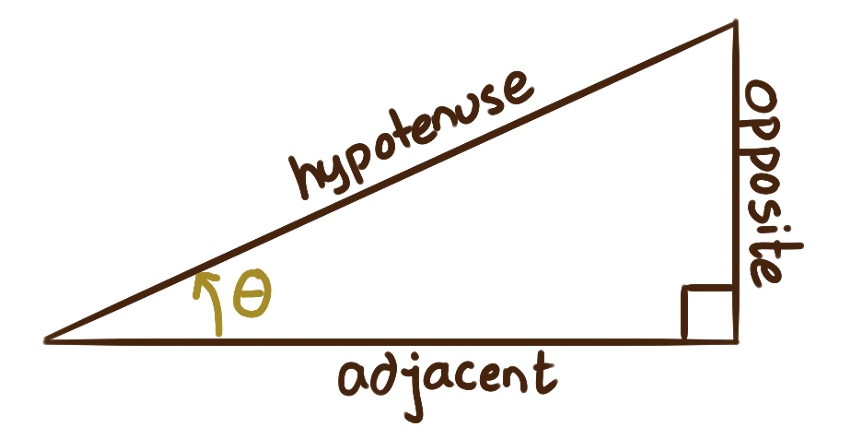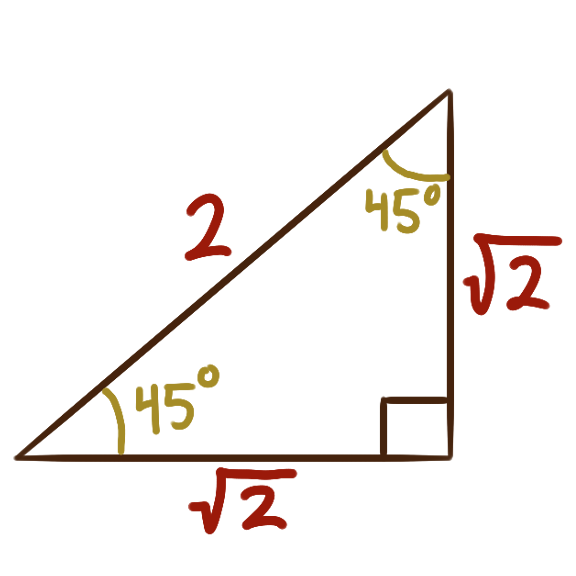 In addition to the coordinates of points on the unit circle,
and in addition to percentages (scaling factors),
the trigonometric functions can be thought of as returning
the ratios of side-lengths of a right triangle with acute angles.
\[
\sin\bigl(\theta\bigr) \!=\! \frac{\text{“opposite”}}{\text{“hypotenuse”}}
\qquad \cos\bigl(\theta\bigr) \!=\! \frac{\text{“adjacent”}}{\text{“hypotenuse”}}
\qquad \tan\bigl(\theta\bigr) \!=\! \frac{\text{“opposite”}}{\text{“adjacent”}}
% \csc\bigl(\theta\bigr) \!=\! \frac{\text{“hypotenuse”}}{\text{“opposite”}}
% \sec\bigl(\theta\bigr) \!=\! \frac{\text{“hypotenuse”}}{\text{“adjacent”}}
% \cot\bigl(\theta\bigr) \!=\! \frac{\text{“adjacent”}}{\text{“opposite”}}
\]
In addition to the coordinates of points on the unit circle,
and in addition to percentages (scaling factors),
the trigonometric functions can be thought of as returning
the ratios of side-lengths of a right triangle with acute angles.
\[
\sin\bigl(\theta\bigr) \!=\! \frac{\text{“opposite”}}{\text{“hypotenuse”}}
\qquad \cos\bigl(\theta\bigr) \!=\! \frac{\text{“adjacent”}}{\text{“hypotenuse”}}
\qquad \tan\bigl(\theta\bigr) \!=\! \frac{\text{“opposite”}}{\text{“adjacent”}}
% \csc\bigl(\theta\bigr) \!=\! \frac{\text{“hypotenuse”}}{\text{“opposite”}}
% \sec\bigl(\theta\bigr) \!=\! \frac{\text{“hypotenuse”}}{\text{“adjacent”}}
% \cot\bigl(\theta\bigr) \!=\! \frac{\text{“adjacent”}}{\text{“opposite”}}
\]
The other trigonometric functions
secant and cosecant and cotangent
can be defined in terms of sine and cosine.

 The three angles within any any triangle sum to 180°.
The right triangles with angles 30°-60°-90° and 45°-45°-90°
correspond to nice algebraic values of sine and cosine.
Two angles \(\theta\) and \(\varphi\) are complementary
if \(\theta + \varphi = 90°;\)
the two non-right angles in a right triangle are complements.
Two angles \(\theta\) and \(\varphi\) are supplementary
if \(\theta + \varphi = 180°,\) if they together they form a half-rotation,
i.e. lie along a straight line.
The three angles within any any triangle sum to 180°.
The right triangles with angles 30°-60°-90° and 45°-45°-90°
correspond to nice algebraic values of sine and cosine.
Two angles \(\theta\) and \(\varphi\) are complementary
if \(\theta + \varphi = 90°;\)
the two non-right angles in a right triangle are complements.
Two angles \(\theta\) and \(\varphi\) are supplementary
if \(\theta + \varphi = 180°,\) if they together they form a half-rotation,
i.e. lie along a straight line.
The area of a triangle with sides of lengths \(A\) and \(B\) and an angle between them that measures \(\theta\) is \(\frac{1}{2}AB\sin\bigl(\theta\bigr).\)